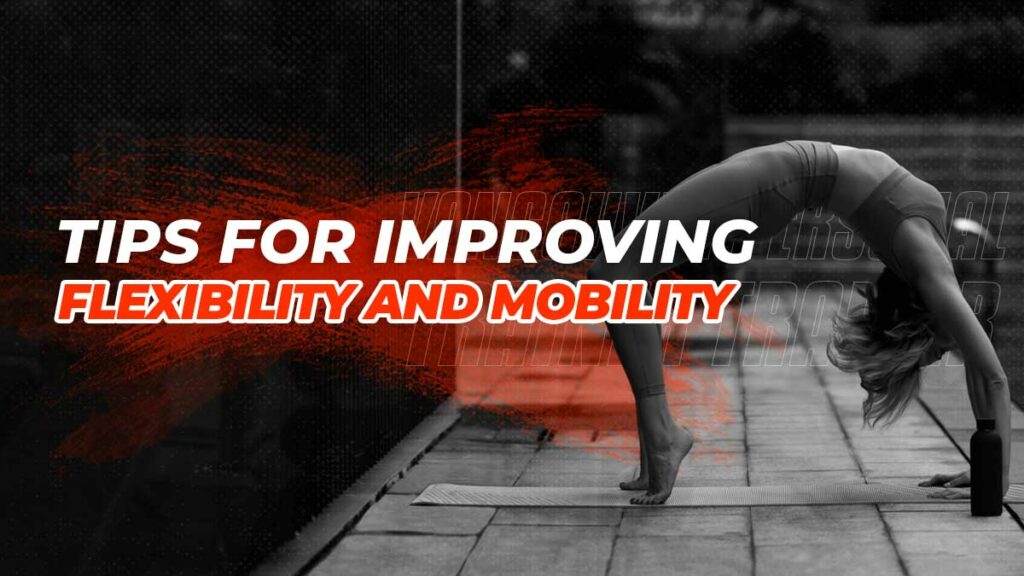
Tips for Improving Flexibility and Mobility
Are you feeling drained, struggling to see results from your workouts, or just looking to better your life? Well, you’re in the right place.
Today, we will talk about flexibility and mobility – two crucial aspects of fitness that often get overlooked.
So, what are flexibility and mobility? Flexibility refers to the extent to which your joints can move, while mobility is the ability to move them through their complete range of motion. Flexibility is the length of your muscles, and mobility is how well you can move them.
You might wonder why flexibility and mobility are important for overall health and fitness. The truth is they play a significant role in helping you prevent injury, move better, and easily perform daily tasks.
Whether you’re running to catch the bus, lifting heavy boxes, or playing sports, having a good level of flexibility and mobility can make all the difference.
In this blog post, we’ll discuss the benefits of improved flexibility and mobility, techniques to enhance them, and tips on incorporating these practices into your daily routine.
So, let’s dig deeper to stay limber and move easily in our busy lives!
5 Benefits of Improved Flexibility and Mobility
Let’s dive into the incredible benefits of improved flexibility and mobility.
1. Improved Athletic Performance
First, you’ll notice a significant improvement in your athletic performance when you increase your flexibility and mobility. That’s because your muscles and joints benefitting from a full range of motions allow your body to work more collaboratively and spontaneously, making your body resistant to any wear and tear. Plus, you’ll be able to easily reach, bend, and twist, making everyday tasks a breeze.
2. Reduced Risk of Injury
Injury is common in everyday life, whether in your workplace, sports, or personal training center. When your body master swift flexibility and mobility, the chances of getting injured from any minor to modest level can easily be subsided. It happens mostly due to your body’s ability to absorb impact and withstand physical stress while keeping any pesky aches and pain at bay.
3. Better Range of Motion
Feeling stiff and limited in your movements? Working on your flexibility and mobility can help you feel a full range of motion, making it easier to perform daily activities and exercises. You’ll be able to move more freely without the discomfort of tight muscles and restricted joints.
4. Increased Functional Movement
Functional movement is about performing everyday tasks with less effort and more efficiency. When your flexibility and mobility are on point, you can squat, lift, push, and pull confidently. So, whether you’re picking up a box or playing with your kids, you’ll be able to enjoy life to the fullest.
5. Enhanced Relaxation and Stress Relief
Cut to the chase; focusing on flexibility and mobility can help you relax and relieve stress. Stretching and mobility exercises can increase blood flow to your muscles, providing a soothing sensation that calms your mind and body. Plus, you’ll feel more comfortable throughout the day by improving your posture and reducing muscle soreness.
There you have it – just a few amazing benefits of improved flexibility and mobility. Ready to make a change for the better? Stay tuned for techniques and tips to help you incorporate flexibility and mobility into your routine. You’ve got this!
7 Techniques for Improving Flexibility and Mobility
Let’s explore some techniques that will help improve your flexibility and mobility. Remember, the key is to start slow and progress gradually. With consistent practice, you’ll be well on your way to a more flexible, mobile, and pain-free lifestyle.
1. Dynamic Stretching
Dynamic stretching involves moving your body through its full range of motion in a controlled manner. This type of stretching is perfect for warming up before workouts, as it helps increase blood flow and prepares your muscles for action. Examples of dynamic stretches include leg swings, arm circles, and side-to-side lunges. Just make sure to keep your movements smooth and controlled to avoid the risk of injury.
2. Static Stretching
Static stretching is about holding a stretch position for a certain period, usually 15-30 seconds. This type of stretching helps lengthen your muscles and improves overall flexibility. Some common static stretches include hamstring stretches, calf stretches, and hip flexor stretches. It’s best to perform static stretching after your workouts when your muscles are warm and more pliable. You are going to feel a stretch.
3. Foam Rolling
Foam rolling, also known as self-myofascial release, can help loosen tight muscles and enhance your flexibility. Applying pressure to specific points on your body using a foam roller can help break up adhesions and knots in your muscles. This leads to decreased muscle soreness and improved mobility. Start by rolling gently and gradually increase the pressure as needed.
4. Yoga
Yoga is an excellent practice for improving flexibility and mobility. The various poses and stretches in yoga target different muscle groups, helping you achieve a full range of motion throughout your body. Yoga also promotes relaxation and stress relief, making it a win-win for your physical and mental well-being.
5. Pilates
Pilates is another great option for enhancing flexibility and mobility. This low-impact workout focuses on strengthening your core, which can improve your posture and overall body alignment. Many Pilates exercises also involve stretching and lengthening your muscles, leading to better flexibility.
6. Mobility Drills
Mobility drills are exercises designed to improve your joint mobility and range of motion. These drills often target specific joints, like your hips, shoulders, or ankles, and can be a great addition to your workout routine. Some popular mobility drills include hip circles, shoulder rolls, and ankle rotations.
7. Massage Therapy
Sometimes, your muscles just need a little tender loving care to release tension and improve flexibility. Massage therapy can help with that! A skilled massage therapist can work out those stubborn knots and adhesions in your muscles, leading to better mobility and reduced pain.
Incorporating these techniques into your routine will set you on the path to improved flexibility and mobility. Just remember to be patient and consistent with your efforts. It’s also a good idea to seek professional guidance if needed, so consider working with a certified personal trainer or physical therapist to ensure you’re practicing the right techniques for your unique needs.
7 Tips for Incorporating Flexibility and Mobility into Your Routine
Here are some practical tips to help you improve your flexibility and mobility without taking too much time out of your busy schedule.
1. Start Slow and Progress Gradually
Don’t dive headfirst into intense stretching or mobility exercises. Begin with gentle movements and stretches, focusing on areas where you feel tightness or discomfort. As your body becomes more accustomed to the exercises, you can gradually increase the intensity and duration of your flexibility and mobility sessions.
2. Make It a Habit
Consistency is key in improving flexibility and mobility. Make it a priority to incorporate stretching and mobility exercises into your daily routine. It can be as simple as taking 5-10 minutes in the morning or before bed to stretch and move your body. You’ll be amazed at how much better you feel after a few weeks.
3. Combine with Strength and Cardio Training
Flexibility and mobility exercises shouldn’t be done in isolation. Combine them with your regular strength and cardio workouts to achieve optimal results. This will not only help you develop well-rounded fitness but also aid in injury prevention and enhance your overall athletic performance.
4. Listen to your body
Pay close attention to how your body feels during and after your flexibility and mobility sessions. If you experience pain or discomfort, back off and try a different stretch or movement. Remember, the goal is to improve your range of motion and reduce muscle soreness, not cause injury.
5. Seek Professional Guidance If Needed
If you’re unsure about proper form or technique, or have specific areas of concern, consider seeking the advice of a professional like Troy Tyrell at Tsquared Personal Training. A personal trainer specializing in flexibility and mobility exercises for decades can help tailor a program that meets your unique needs and ensures you’re performing the exercises safely and rightly.
6. Make Sure You Pay Attention to Your Body
It’s crucial to maintain proper form during flexibility and mobility exercises. This will help minimize the risk of injury and ensure you’re effectively targeting the intended muscles and joints. Focus on slow, controlled movements and avoid bouncing or jerking, which can lead to injury.
7. Take a Seat on the Floor
If you spend most of your day sitting at a desk, try incorporating some floor-based stretches and mobility exercises into your routine. Sitting on the floor encourages you to engage your core muscles, maintain proper posture, and stretch your hip flexors.
By following and making these exercises a regular part of your fitness routine, you’ll feel more energetic, reduce the risk of injury, and ultimately live a healthier, more balanced life.
Improve Your Flexibility and Mobility Now
Prioritizing flexibility and mobility in your fitness routine is essential for busy professionals like you. It will enhance your athletic performance and reduce the risk of injury, improve your range of motion, and contribute to better functional movement. Plus, it can provide you with some much-needed relaxation and stress relief amid your hectic schedule.
Remember, incorporating flexibility training and mobility into your routine doesn’t have to be complicated. Start slow, progress gradually, and make it a habit. Combine it with your strength and cardio training to maximize the benefits, and always listen to your body. If you’re unsure about your form or need guidance, don’t hesitate to seek professional help.
Are you ready to take your flexibility and mobility to the next level? Tsquared Personal Training is here to help! With Troy Tyrell’s 20 years of experience and dedication to safety, correct form, and advanced techniques, you can trust that you’re in good hands.
Whether you’re interested in private personal training or small fitness classes, we’ll provide the attention and guidance you need to achieve your goals. Say goodbye to feeling sluggish and hello to a more active, pain-free life!
Contact us today to schedule your first session and start experiencing the benefits of increased flexibility and mobility.
FAQ: Flexibility and Mobility Questions Answered
Q: What improves flexibility and joint mobility?
A: To improve flexibility and joint mobility, you can incorporate a combination of dynamic stretching, static stretching, foam rolling, yoga, Pilates, mobility drills, and massage therapy into your routine. Each of these techniques targets different aspects of flexibility and mobility, so finding a balance that works best for your body and goals is essential.
Q: What causes improved flexibility?
A: Improved flexibility comes from regularly engaging in activities and exercises that stretch your muscles and joints, allowing them to lengthen and become more pliable over time. Consistency is key, so make sure to incorporate flexibility exercises into your routine several times a week to see the best results.
